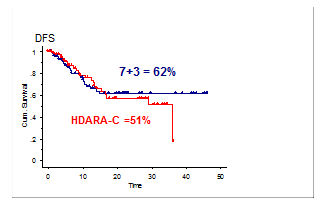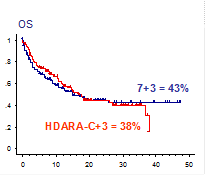Abstract
Introduction.
The vast majority of AML clinical trials incorporate high-dose ARA-C (HDARA-C) as a basic approach. Though it was recently proved by a controlled prospective comparison that different treatment strategies in patients with AML did not show clinically relevant outcome differences (Th.Buchner, JCO, 2012), the RALSG initiated a randomized multicenter AML-10 trial (ClinicalTrials.gov Identifier: NCT01587430) aiming to evaluate the necessity of HDARA-C in consolidation in the context of high total dose of different anthracyclines/anthracenedione (660-720 mg/m2).
Materials and methods.
The patients aged 16-60 yy with de novo AML (except APL) were randomized before treatment start to different types of consolidation after two induction 7+3 with daunorubicin 60 mg/m2x3 and ARA-C 100 mg/m2 bid iv (1-7d) in the 1st course and 200 mg/m2/d (1-7d) continuous infusion in the 2nd course: (1st arm) two courses of 7+3 with Idarubicin (Ida) 12 mg/m2x3 and with Mitoxantrone (Mito) 10 mg/m2x3, in both ARA-C 100 mg/m2 bid iv (1-7d); (2nd arm) two courses of HDARA-C 1g/m2 bid iv 1-3 days with Ida 8 mg/m2 3-5 days and Mito10 mg/m2 3-5 days. After consolidation all pts proceeded to the maintenance 5+5 courses (ARA-C 100 mg/m2 bid iv 1-5 days with 6-mercaptopurine 50 mg/m2 1-5 days). Allogeneic HSCT was indicated to patients from intermediate and poor cytogenetic risk groups, late CR, WBC > 100*109/l.
Results.
From Jan 2010 till Jan 2014, 250 AML patients from 20 centers were randomized: (1st arm) 125 pts (m.age 45 y, 17-59 yy; 73f / 52m; LDH=674 IU (128-6653); cytogenetics favorable - 17,3%, intermediate - 66,7%, poor - 16%) and (2nd arm) 125 pts (m.age 43y, 16-60yy; 69f/56m; LDH=704 IU (123-8159); cytogenetics favorable - 20%, intermediate - 58,6%, poor - 21,4%). No molecular testing in cytogenetically normal pts was done. The analysis was performed in May 2014. The follow-up data were available in 199 pts.
CR was achieved in 72,9% (n=145), early death was registered in 12,7% (n=25) and refractory disease - in 12,4% (n=24). Death in CR did not differed in a randomized groups (1st) 13,9% and (2nd) 13,7%. 17% of CR pts (n=20) were withdrawn from the protocol due to refusals (3,5%), infectious complications (13,5%). No relevant cardiotoxicity was registered on both arms. 12% (8 pts on the 1st arm, 9 - on the 2nd) were transplanted in 1st CR from HLA-identical donors.
3-years OS and DFS by intent-to-treat analysis were identical on both arms: (1st arm) 43% and 62%, (2nd arm) - 38% and 51%, respectively. For those patients in whom consolidation was fulfilled the comparison of DFS in different cytogenetic groups demonstrated equal efficacy of each consolidation arm: favorable - 85% (1st) and 85% (2nd), intermediate -65% (1st) and 57% (2nd), poor - 20% (1st) and 22% (2nd). In a multivariate analysis only cytogenetic group (HR=3,01, p=0,005) and CR achievement after the 2nd induction course (HR=2,83, p=0,0007) adversely influenced DFS. As the land-mark (5 mo of CR) analysis have shown, the bad prognosis of late CR could be modified by allo-HSCT in 1st CR: DFS of transplanted patients = 86%, non-transplanted=27% (p=0,03).
Conclusion.
Our interim analysis has demonstrated that conventional 7+3 consolidation is equal in long-term outcome to high dose ARA-C in case of the high total doses of different anthracyclines/ anthracenedione in induction/consolidation. CR after the 2nd induction became independent adverse prognostic factor (even inside cytogenetic risk groups) defining patients who should be transplanted in 1st CR.
No relevant conflicts of interest to declare.
Author notes
Asterisk with author names denotes non-ASH members.



This feature is available to Subscribers Only
Sign In or Create an Account Close Modal